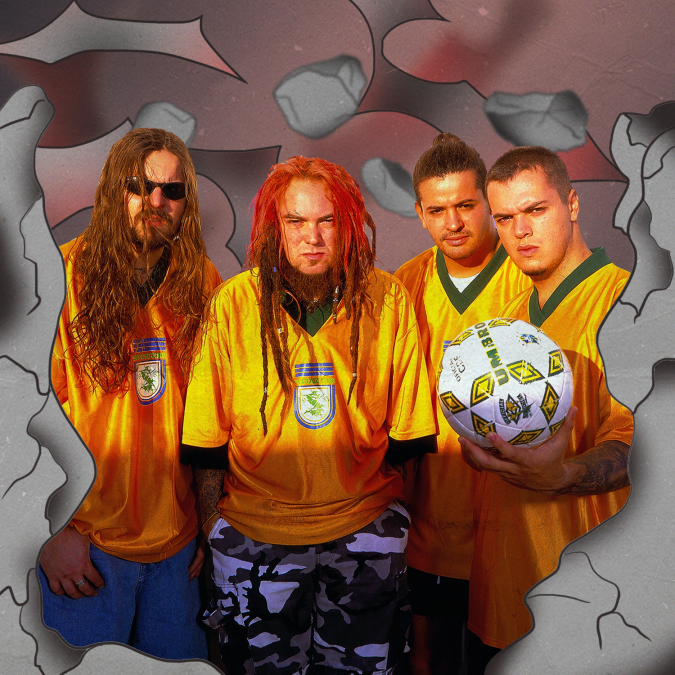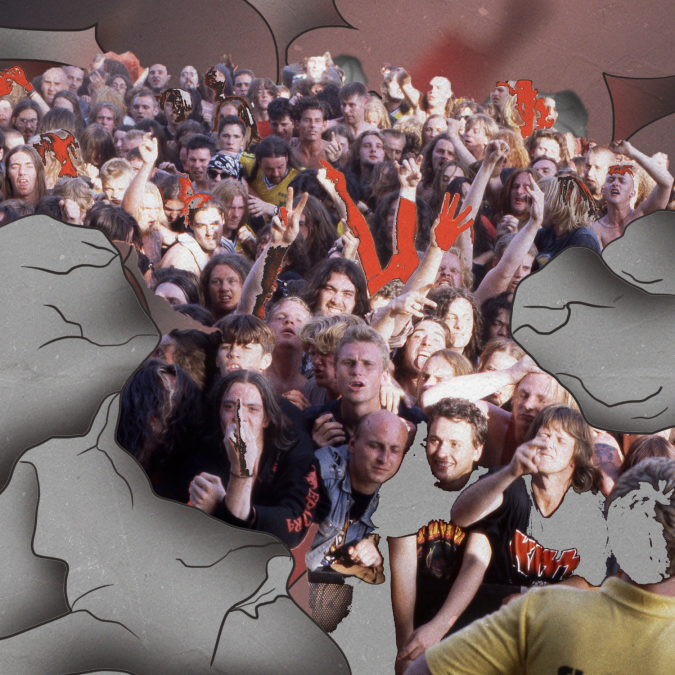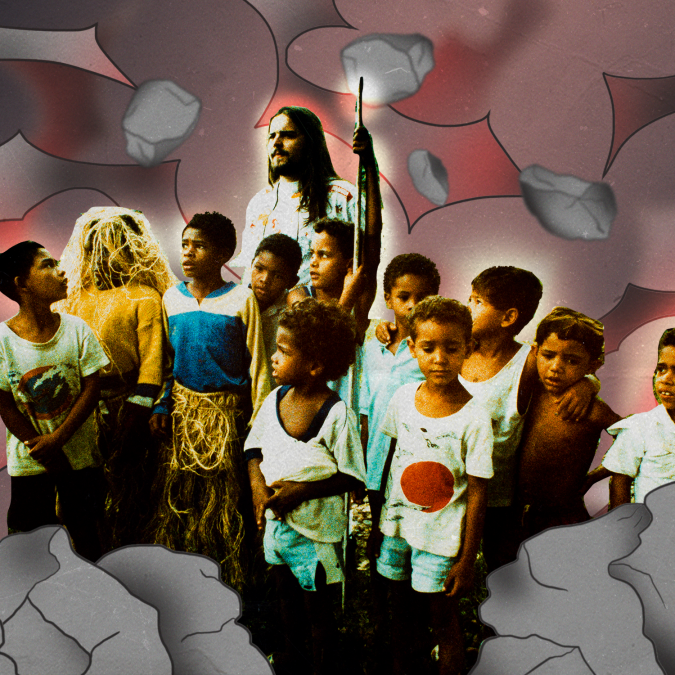In the mid to late ‘90s, something funny simultaneously happened in U.S. pop culture. Shiny, innocent-sounding pop like Britney Spears and the Backstreet Boys dominated the charts, radio, and MTV. But there was also dark, brooding, sexual metal music on full display. Bands that became known as nu metal – Korn, Deftones, and Limp Bizkit — caused shock and awe with their combination of heavy riffs, DJ scratches, and rap-like vocals. But before nu metal blew up and its relevance, or lack thereof, started being debated in the metal realm, a band with a highly respected career and discography decided to put their take on the genre. That was the birth of Roots, Brazilian band Sepultura’s seventh studio album, which went into a new direction for the group.
At that point, Sepultura had been around for more than a decade. The band formed in 1984 and established itself as a creative and influential act within thrash and death metal worldwide, mainly with the albums Beneath the Remains (1989) and Chaos A.D. (1991). By 1995, the band decided it was time to change things up and pursue a slower, groovier sound. To make this work, they invited nu metal producer Ross Robinson to work on their next album.

But Roots wasn’t only nu metal. It also drew from a lot of groove metal and also went beyond heavy music, incorporating folklore, indigenous music, and drums from blocos afro (Carnaval groups of percussion from Bahia) as Sepultura searched into their Brazilian roots. It was refreshing for metal and rock music in general. And to this day, it is considered one of the best and most popular albums in the band’s discography, with “Roots Bloody Roots” being one of Sepultura’s biggest hits.
Roots was so popular that brothers Max (guitar and vocals) and Igor Cavalera (drums) toured Latin America this July and Aug. to celebrate the record’s 25th anniversary. Max quit Sepultura in 1996 right after the album’s release to form his own distinctively nu-metal project Soulfly, and Igor left in 2006 because of personal issues. Since 2007, the brothers have been touring and recording together as Cavalera Conspiracy, where they play some Sepultura songs. This year, they are celebrating Roots by touring Mexico, Colombia, Chile, Brazil, and other countries where alternative metal scenes were formed at the time of the album’s release.

It’s the case of Medellín, Colombia. The city had a strong post-punk and goth scene in the ‘90s, and that’s where members of the band Nepentes met in 1998. By the end of the decade, Colombian rock music was also heavily influenced by aggressive hardcore punk and groove metal, but Nepentes were still looking for their own sound. That’s where Roots came in.
“We were already listening to nu metal – Deftones, Korn, Limp Bizkit, [Mexican band] Resorte. But then I remember everyone started talking about Roots,” says Juan Fernando Álvarez, the band’s singer, via email. “They were the new heroes. It was very innovative and, of course, that was also an influence for Nepentes years later.”

In 1998, Nepentes released their first EP, Latinoamérica tierra de inocentes (“Latin America, innocent’s land”), with heavy riffs and politically charged lyrics on social issues like economic disparity, which have followed the band into their present days, despite nu metal’s fame of being vapid. The political lyrics are also an important part of Roots, which deals greatly with indigenous issues and Brazilian political history, like the military dictatorship. “We have always taken advantage of the genre to make these issues sound even more aggressive,” Álvarez notes.

In fact, the aggressiveness of nu metal in Latin America made the genre come to be known as aggro metal in some countries – especially Chile. One of the most successful Chilean aggro metal bands at the time was Dracma, formed in 1996 by vocalist Felipe “Felo” Foncea, his brother, drummer Cote Foncea, and three other friends.
“[We listened to] a lot of rock, but we also come from a school with a lot of soul, Latin music (Brazilian, Argentine, Peruvian), folklore music, etc,” says Felo via email. Dracma’s first self-titled album came out in 1999. The playful, distorted guitar riffs and Felo’s contagious flow made Dracma blow up in the Chilean rock scene and guaranteed that the band played many big shows, including opening for Korn in 2002 and even Sepultura in 2003.
“It was a brutal show. We found a lot of connection with the band and the audience,” Felo recounts. “Sepultura was a huge influence, and Roots demonstrated that metal can be linked to the folklore of each country. It helped many young musicians look at their own musical roots and try those mixtures.”

Roots’ links to Latin American folklore went far beyond just referencing it. During the album’s conception, the band traveled to Mato Grosso and met with Xavante people to record with them. Their particular sound and way of approaching music stuck with Sepultura, and references to indigenous and Brazilian cultures, in general, are all over the album. For example, in “Roots Bloody Roots,” which is literally about getting in touch with one’s roots, “Ratamahatta,” which references Brazilian favelas, and “Ambush,” a tribute to Chico Mendes, an advocate for the preservation of the Amazon rain-forest who was murdered in 1988.

For Zhândio Huku, vocalist and founder of the Brazilian indigenous folk metal band Arandu Arakuaa, Roots is a “classic record and a source of pride for all of Latin America,” he says via email. “From the cover art to [the track] ‘Itsári,’ recorded with the Xavante, the indigenous issues are all over the album.”
Zhândio moved from Tocantins to Brasília in 2008 in order to form Arandu Arakuaa. For him, rock and metal are still very urban genres, distant from where he grew up, where he used to listen to a lot of regional Brazilian music like baião and vaquejada. The band’s music is heavily influenced by those genres, and their lyrics, written in indigenous languages like Tupi, Xerente, and Xavante, speak on the people’s struggles, legends, and rites.

“There still aren’t a lot of indigenous rock or metal bands,” says Zândhio. “But anyone who lives in this land that we now call Brazil should be aware that this is Indigenous Land. Therefore, defending indigenous people is not a favor, it should be an obligation.”
Though Max, Igor, and the rest of the original members of the band are not indigenous, Roots did exactly what Zândhio calls for. And 25 years since its release, it’s legacy is still present in Brazil and the rest of Latin America. The posters promoting the tour declare that “O futuro é indígena,” or “the future is indigenous.” By drawing from our collective past, Roots shaped the future.




